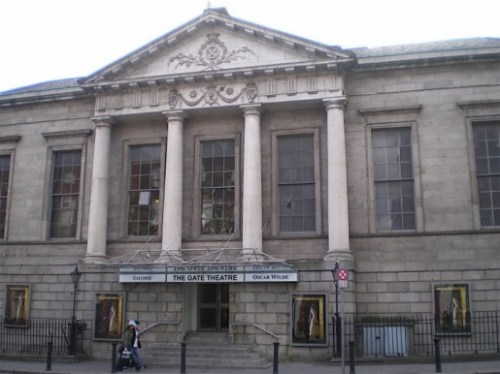 The seizure of the Rotunda concert hall by a reasonably large group of unemployed workers, and the hoisting of the red flag over the premises, remains one of the most bizarre and understudied events of the Irish revolutionary period.
The seizure of the Rotunda concert hall by a reasonably large group of unemployed workers, and the hoisting of the red flag over the premises, remains one of the most bizarre and understudied events of the Irish revolutionary period. The story of this event is enjoyably recounted on the Come Here to Me website which covers the political, social, and radical history of Baile Atha Cliath. The article is reproduced with the kind permission of the author. Go raibh maith agat Donal.
The seizure of the Rotunda by unemployed people had as one of its leaders a man called Liam o'Flaherty who like many unemployed was in an Irish unit of the British army in WW1 before entering radical left politics, the Citzen Army and eventually seeing action with the anti-treaty forces in the civil war.
In his excellent history of the ITGWU, The Irish Transport and General Workers’ Union: The Formative Years C. Desmond Greaves wrote that, early in 1922 “….industrial conflict took the form of individual struggles rather than a concerted class war.” The occupation of the Rotunda came two days after the foundation of the new state, and was perhaps the earliest example of class anger within it, a direct response to the existing high levels of unemployment. One of the leading figures of this occupation was Liam O’ Flaherty, today well-known as the author of The Informer, the classic novel, but then acting as a dedicated socialist.
 He, like so many other unemployed men in Dublin, had served in the Great War, serving with the Irish Guards. He had been on a strange journey before returning to Dublin, and Emmet O’ Connor notes in Reds and the Greens that “After being invalided out of the British Army he set off trampling about the Mediterranean and the Americas, joining the Wobblies in Canada and the Communist Party in New York. He returned to settle in Ireland in December 1921….”
He, like so many other unemployed men in Dublin, had served in the Great War, serving with the Irish Guards. He had been on a strange journey before returning to Dublin, and Emmet O’ Connor notes in Reds and the Greens that “After being invalided out of the British Army he set off trampling about the Mediterranean and the Americas, joining the Wobblies in Canada and the Communist Party in New York. He returned to settle in Ireland in December 1921….”On January 18 1922, a group of unemployed Dublin workers seized the concert hall of the Rotunda. The Irish Times of the following day noted that:
“The unemployed in Dublin have seized the concert room at the Rotunda, and they declare that they will hold that part of the building until they are removed, as a protest against the apathy of the authorities.”
“A ‘garrison’, divided into ‘companies’, each with its ‘officers’ has been formed, and from one of the windows the red flag flies”
Liam O’ Flaherty, as chairman of the ‘Council of Unemployed’, spoke to the paper about the refusal of the men to leave the premises, stating that no physical resistance would be put up against the police and that the protest was a peaceful one, yet they intended to stay where they were.
“If we were taken to court, we would not recognise the court, because the Government that does not redress our grievances is not worth recognising” O’ Flaherty told the Times.
A manifesto was issued by the occupiers, the first publication of O’ Flaherty. O’ Connor notes in his study that “Their manifesto was O’ Flaherty’s first publication. One could say that Phelan (A reference to a CPI comrade of O’ Flaherty, Jim Phelan) was impressed. ‘It’s language has not, I think, been approached since the days of the American War of Independence and the first French Revolution’ “
A later Irish Times report gives some idea of the level of organisation involved in such an occupation. On January 20 the paper noted that a man had been court martialed and reduced to the ranks. “…we reduced him to the ranks for disobeying orders” the paper quoted the “leader of the men” as saying. By that stage, two days into the occupation, around 200 men were present.
The paper noted a maintainance fund had been established, with Bolands bakery on Capel Street making a grant of 500 loaves to the men. The paper also noted that sporadic concerts had taken place inside the occupation, and that “A meeting of the unemployed was held during the day yesterday, and the “garrison” paraded Parnell Square”.
Of course, many Dubliners were extremely hostile to the sight of the red flag in Dublin. Angry demonstrations occurred each night during the occupation, and the Irish Independent noted (January 21) that “About 8.30 last night a hostile crowd of about 500 assembled in Cavendish Row, and indulged in shouts and derisive cheers. About 10pm a young fellow made an attempt to reach the red flag hung out from a window, but fell to the ground. He was taken to Jervis St. Hospital, but he was not detained.” When the flag was removed, the crowd cheered loudly.It was only thanks to the Dublin Metropolitan Police and the Republican Police that those inside the Rotunda were unharmed, as the crowd stormed the building. It was becoming clear the occupation was not sustainable. On the Thursday night, a member of the occupying group had been attacked collecting money near the premises, and since then tensions had been high.
The occupation, which had begun on Wednesday, was to end late on Saturday night. As the hatred outside intensified, shots were fired over the heads of the mob from inside the hall. Just before midnight, and under the protection of the combined police forces, the occupiers left the building and the crowd soon departed without incident. O’ Flaherty took off for Cork.
O’ Flaherty would later fight in the Irish Civil War, one of the socialists present in Vaughan’s Hotel, a republican seizure of note owing to the fact it was a favourite meeting place of a certain Michael Collins during the War of Independence! O’ Flaherty is not the only Irish writer of note to have partaken in the Civil War of course, with Sean O’ Faoláin just one other example. The early parts of 1922 saw much industrial unrest, and a number of creameries in the south of Ireland were sized in May. Greaves noted in his prior mentioned study of the history of the ITGWU that the Labour Party and TUC had attempted to “…ensure the neutrality of the Citizen Army by incorporating it into a ‘Workers Army’ that would cover the whole country….But no army can fight for neutrality, and the project soon fell through”
Still, the physical battles between two armed factions and the class conflict remained more or less disconnected from one another. An editorial in the Workers Republic, printed on July 22 1922, noted
“What will attract the masses to support the Republicans? At present, they cannot see any benefit in fighting for it! At present the Free State offers them more economic and social advantages. At the moment it seems as if the Labour Party, representative of the masses, can find its salvation in the Free State rather than in the Republic”

Liam Mellows, perhaps the republican figure who fought hardest for republicanism to add a real social dimension to its goals, was to be executed in a hail of bullets. His now famous prison notes noted that “In our efforts now to win back public support to the Republic we are forced to recognise whether we like it or not- that the commercial interest, so-called, money and the gombeen men are on the side of the Treaty”
The occupation of the Rotunda remains an often overlooked piece of the history of the period. Before Mellows penned the above, O’ Flaherty and a small band of followers had demanded a Workers Republic, and nothing short thereof. In Irish history, the Rotunda is seen as being of great importance as the site of the foundation of the Irish Volunteers. Sadly, no plaque marks the workers occupation of the site in 1922.

No comments:
Post a Comment